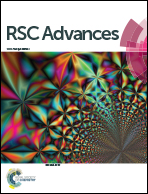Electrochemically prepared nanoporous gold as a SERS substrate with high enhancement
Abstract
Single-molecule surface-enhanced Raman scattering (SM-SERS) utilizes localized surface plasmons in metallic nanostructures for enhanced signal detection. This work demonstrates the use of SM-SERS on an electrochemically anodized biocompatible nanoporous gold (NpAu) substrate using a bi-analyte Raman technique. It was found that the positions (so-called hot-spots) with the closest etched valley widths (w), or the smallest w/valley wall width (D) (ligaments), of the Au nanopores dominated the Raman scattering. By using an etched substrate with a w < 10 nm and a w/D < 0.2 an estimated enhancement factor of ∼107 for both Nile blue and Rhodamine 6G dyes was achieved. Importantly, the bi-analyte Raman technique enabled the clear confirmation of single (or few) molecule detection on the Np/Au substrates.


 Please wait while we load your content...
Please wait while we load your content...